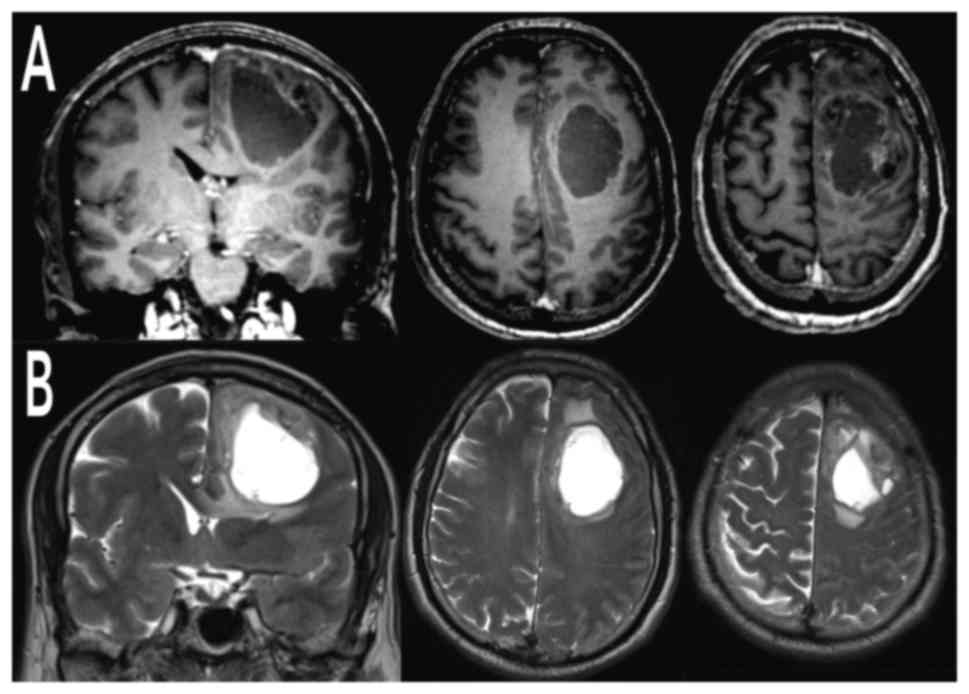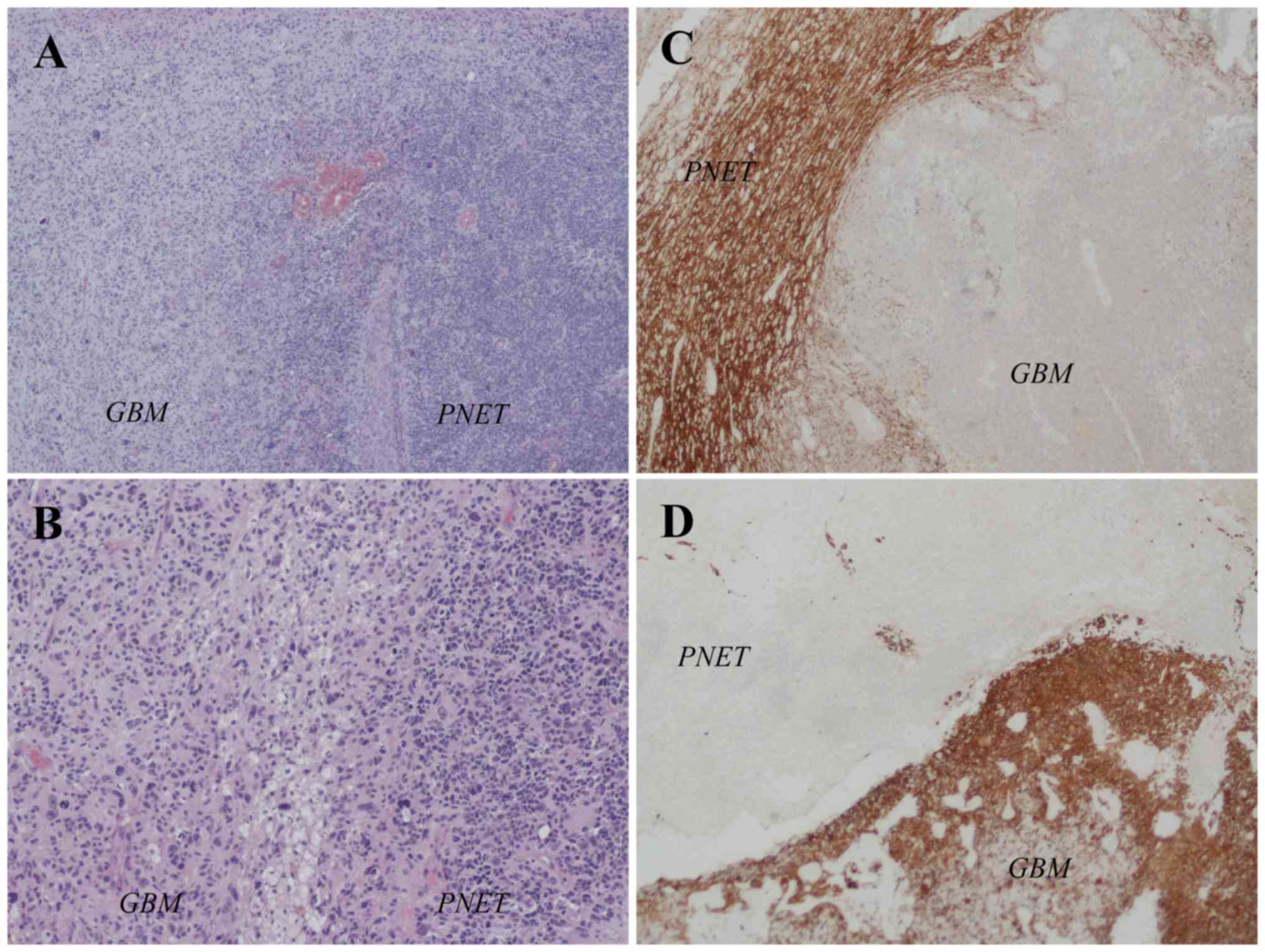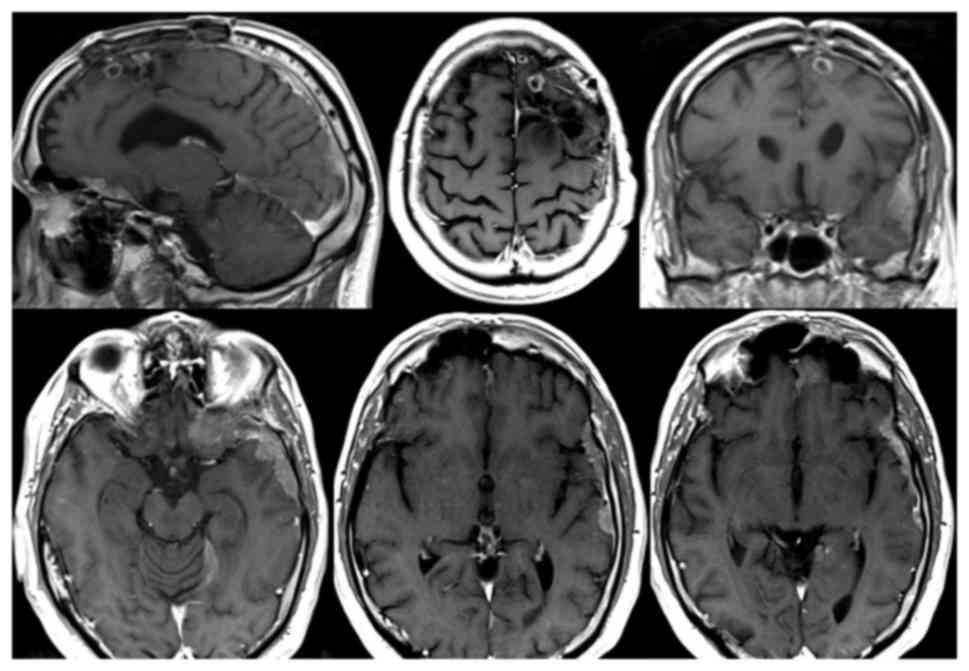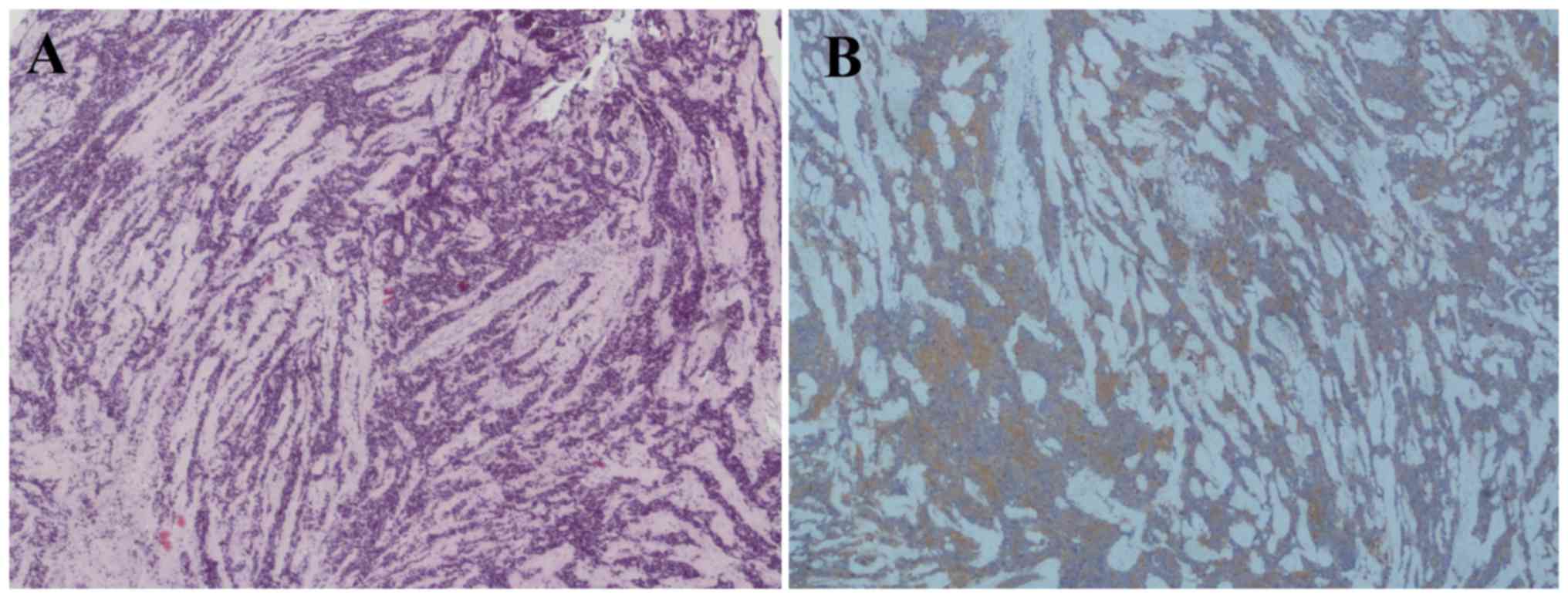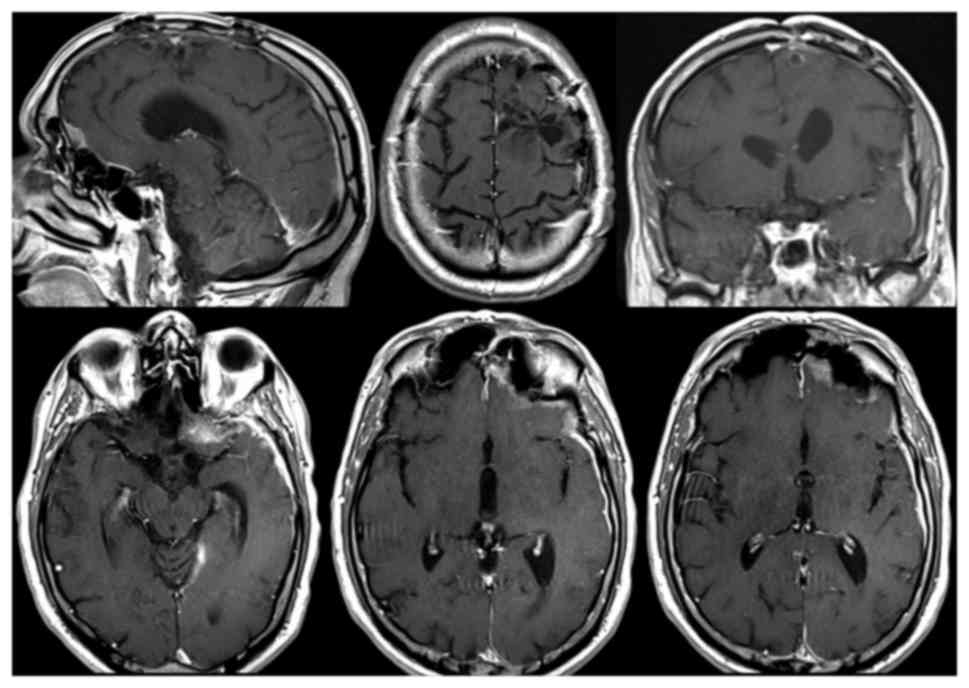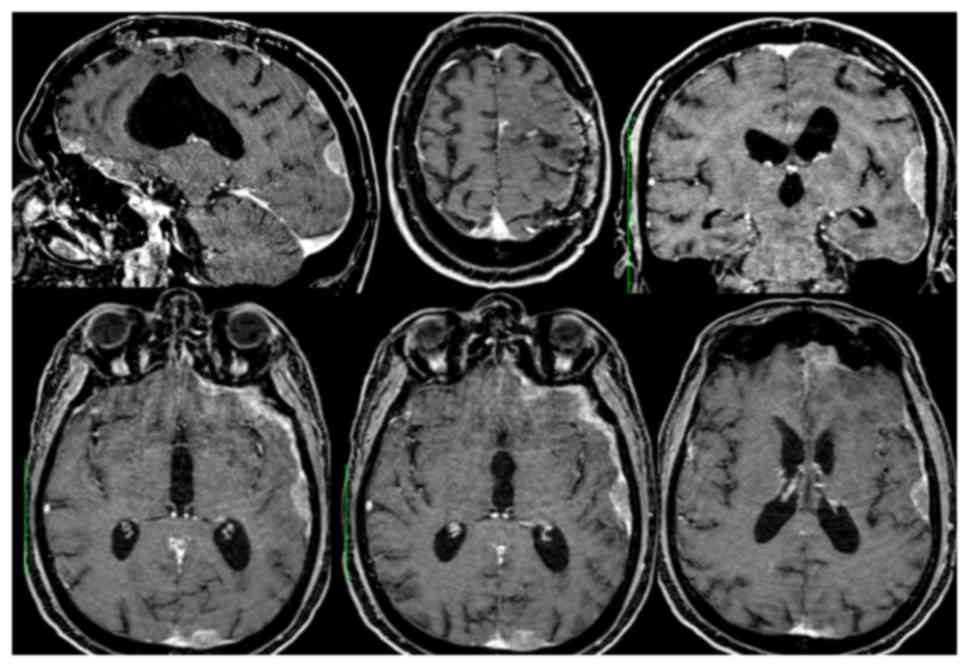|
1
|
Ostrom QT, Gittleman H, Farah P, Ondracek
A, Chen Y, Wolinsky Y, Stroup NE, Kruchko C and Barnholtz-Sloan JS:
CBTRUS statistical report: Primary brain and central nervous system
tumors diagnosed in the united states in 2006–2010. Neuro Oncol. 15
Suppl 2:ii1–i56. 2013. View Article : Google Scholar : PubMed/NCBI
|
|
2
|
Han BR, Choi HJ, Yang JS, Kang SH, Cho YJ
and Choi KC: Emerging variant glioma: Glioblastoma with a primitive
neuro-ectodermal tumor (PNET) component. The Nerve. 1:40–43. 2015.
View Article : Google Scholar
|
|
3
|
Stupp R, Hegi ME, Mason WP, van den Bent
MJ, Taphoorn MJ, Janzer RC, Ludwin SK, Allgeier A, Fisher B,
Belanger K, et al: Effects of radiotherapy with concomitant and
adjuvant temozolomide versus radiotherapy alone on survival in
glioblastoma in a randomised phase III study: 5-year Analysis of
the EORTC-NCIC trial. Lancet Oncol. 10:459–466. 2009. View Article : Google Scholar : PubMed/NCBI
|
|
4
|
Stupp R, Mason WP, van den Bent MJ, Weller
M, Fisher B, Taphoorn MJ, Belanger K, Brandes AA, Marosi C, Bogdahn
U, et al: Radiotherapy plus concomitant and adjuvant temozolomide
for glioblastoma. N Engl J Med. 352:987–996. 2005. View Article : Google Scholar : PubMed/NCBI
|
|
5
|
Louis DN, Ohgaki H, Wiestler OD, Cavenee
WK, Burger PC, Jouvet A, Scheithauer BW and Kleihues P: The 2007
WHO classification of tumours of the central nervous system. Acta
Neuropathol. 114:97–109. 2007. View Article : Google Scholar : PubMed/NCBI
|
|
6
|
Karsy M, Gelbman M, Shah P, Balumbu O, Moy
F and Arslan E: Established and emerging variants of glioblastoma
multiforme: Review of morphological and molecular features. Folia
Neuropathol. 50:301–321. 2012. View Article : Google Scholar : PubMed/NCBI
|
|
7
|
Perry A, Miller CR, Gujrati M, Scheithauer
BW, Zambrano SC, Jost SC, Raghavan R, Qian J, Cochran EJ, Huse JT,
et al: Malignant gliomas with primitive neuroectodermal tumor-like
components: A clinicopathologic and genetic study of 53 cases.
Brain Pathol. 19:81–90. 2009. View Article : Google Scholar : PubMed/NCBI
|
|
8
|
Chu A, Bourgeois DJ and Prasad D: A
responsive yet persistently recurrent GBM with PNET features. Appl
Rad Oncol. 4:28–30. 2015.
|
|
9
|
Forbes V and Vredenburgh J: Primitive
neuroectodermal tumor with glioblastoma multiforme components in an
adult: A collision tumor. Cureus. 8:e4562016.PubMed/NCBI
|
|
10
|
Kim DG, Lee DY, Paek SH, Chi JG, Chloe G
and Jung HW: Supratentorial primitive neuroectodermal tumors in
adults. J Neurooncol. 60:43–52. 2002. View Article : Google Scholar : PubMed/NCBI
|
|
11
|
O'Leary B, Mandeville HC, Fersht N, Solda
F, Mycroft J, Zacharoulis S, Vaidya S and Saran F: Craniospinal
irradiation with concomitant and adjuvant temozolomide-a
feasibility assessment of toxicity in patients with glioblastoma
with a PNET component. J Neurooncol. 127:295–302. 2016. View Article : Google Scholar : PubMed/NCBI
|
|
12
|
Kandemir NO, Bahadir B, Gül S, Karadayi N
and Ozdamar SO: Glioblastoma with primitive neuroectodermal
tumor-like features: Case report. Turk Neurosurg. 19:260–264.
2009.PubMed/NCBI
|
|
13
|
Karina A, Jonker BP, Morey A, Selinger C,
Gupta R and Buckland ME: Glioblastoma with primitive
neuroectodermal tumour-like components. Pathology. 44:270–273.
2012. View Article : Google Scholar : PubMed/NCBI
|
|
14
|
Ali S, Joseph NM, Perry A, Barajas RF Jr
and Cha S: Apparent diffusion coefficient in glioblastoma with
PNET-like components, a GBM variant. J Neurooncol. 119:353–360.
2014. View Article : Google Scholar : PubMed/NCBI
|
|
15
|
Song X, Andrew Allen R, Terence Dunn S,
Fung KM, Farmer P, Gandhi S, Ranjan T, Demopoulos A, Symons M,
Schulder M and Li JY: Glioblastoma with PNET-like components has a
higher frequency of isocitrate dehydrogenase 1 (IDH1) mutation and
likely a better prognosis than primary glioblastoma. Int J Clin Exp
Pathol. 4:651–660. 2011.PubMed/NCBI
|
|
16
|
Gessi M, Setty P, Bisceglia M, zur Muehlen
A, Lauriola L, Waha A, Giangaspero F and Pietsch T: Supratentorial
primitive neuroectodermal tumors of the central nervous system in
adults: Molecular and histopathologic analysis of 12 cases. Am J
Surg Pathol. 35:573–582. 2011. View Article : Google Scholar : PubMed/NCBI
|
|
17
|
Hayden JT, Frühwald MC, Hasselblatt M,
Ellison DW, Bailey S and Clifford SC: Frequent IDH1 mutations in
supratentorial primitive neuroectodermal tumors (sPNET) of adults
but not children. Cell Cycle. 8:1806–1807. 2009. View Article : Google Scholar : PubMed/NCBI
|
|
18
|
Kimbason T, Turner SG, Kazmi SA, Fourgas
E, Gergel T, Belles L, Whitmire A, Lacroix M and Toms SA: Malignant
glioma with primitive neuroectodermal components: Clinical and
pathologic features with treatment modalities of five cases. J Clin
Exp Pathol. 5:2552015. View Article : Google Scholar
|
|
19
|
Varlet P, Soni D, Miquel C, Roux FX, Meder
JF, Chneiweiss H and Daumas-Duport C: New variants of malignant
glioneuronal tumors: A clinicopathological study of 40 cases.
Neurosurgery. 55:1377–1391. 2004. View Article : Google Scholar : PubMed/NCBI
|
|
20
|
Karina A, Jonker BP, Morey A, Selinger C,
Gupta R and Buckland ME: Glioblastoma with primitive
neuroectodermal tumour-like components. Pathology. 44:270–273.
2012. View Article : Google Scholar : PubMed/NCBI
|
|
21
|
Davis ME: Glioblastoma: Overview of
disease and treatment. Clin J Oncol Nurs. 20:S2–S8. 2016.
View Article : Google Scholar : PubMed/NCBI
|
|
22
|
Konar SK, Bir SC, Maiti TK, Patra DP,
DiPoto Brahmbhatt AC, Jacobsohn JA and Nanda A: Early dural
metastasis from a case of glioblastoma with primitive
neuroectodermal differentiation: A case report and literature
review. J Clin Neurosci. 35:78–81. 2017. View Article : Google Scholar : PubMed/NCBI
|
|
23
|
Szopa W, Burley TA, Kramer-Marek G and
Kaspera W: Diagnostic and therapeutic biomarkers in glioblastoma:
Current status and future perspectives. Biomed Res Int.
2017:80135752017. View Article : Google Scholar : PubMed/NCBI
|
|
24
|
Lee APS, Brewer J, Back M and Wheeler H:
Combination therapy for glioblastoma multiforme with primitive
neuroectodermal tumor components: Case series. J Clin Oncol. 30
Suppl 15:e125072012.
|
|
25
|
Mostafa H, Pala A, Högel J, Hlavac M,
Dietrich E, Westhoff MA, Nonnenmacher L, Burster T, Georgieff M,
Wirtz CR and Schneider EM: Immune phenotypes predict survival in
patients with glioblastoma multiforme. J Hematol Oncol. 9:772016.
View Article : Google Scholar : PubMed/NCBI
|
|
26
|
Xue S, Hu M, Iyer V and Yu J: Blocking the
PD-1/PD-L1 pathway in glioma: A potential new treatment strategy. J
Hematol Oncol. 10:812017. View Article : Google Scholar : PubMed/NCBI
|
|
27
|
Ho WL, Hsu WM, Huang MC, Kadomatsu K and
Nakagawara A: Protein glycosylation in cancers and its potential
therapeutic applications in neuroblastoma. J Hematol Oncol.
9:1002016. View Article : Google Scholar : PubMed/NCBI
|
|
28
|
Wang Z, Guo Q, Wang R, Xu G, Li P, Sun Y,
She X, Liu Q, Chen Q, Yu Z, et al: The D domain of LRRC4 anchors
ERK1/2 in the cytoplasm and competitively inhibits MEK/ERK
activation in glioma cells. J Hematol Oncol. 9:1302016. View Article : Google Scholar : PubMed/NCBI
|
|
29
|
Liu X, Chong Y, Tu Y, Liu N, Yue C, Qi Z,
Liu H, Yao Y, Liu H, Gao S, et al: CRM1/XPO1 is associated with
clinical outcome in glioma and represents a therapeutic target by
perturbing multiple core pathways. J Hematol Oncol. 9:1082016.
View Article : Google Scholar : PubMed/NCBI
|
|
30
|
Li B, Huang MZ, Wang XQ, Tao BB, Zhong J,
Wang XH, Zhang WC and Li ST: TMEM140 is associated with the
prognosis of glioma by promoting cell viability and invasion. J
Hematol Oncol. 8:892015. View Article : Google Scholar : PubMed/NCBI
|
|
31
|
Mao JM, Liu J, Guo G, Mao XG and Li CX:
Glioblastoma vasculogenic mimicry: Signaling pathways progression
and potential anti-angiogenesis targets. Biomark Res. 3:82015.
View Article : Google Scholar : PubMed/NCBI
|
|
32
|
Braoudaki M and Lambrou GI: MicroRNAs in
pediatric central nervous system embryonal neoplasms: The known
unknown. J Hematol Oncol. 8:62015. View Article : Google Scholar : PubMed/NCBI
|
|
33
|
Kelleher FC and Thomas DM: Molecular
pathogenesis and targeted therapeutics in ewing sarcoma/primitive
neuroectodermal tumours. Clin Sarcoma Res. 2:62012. View Article : Google Scholar : PubMed/NCBI
|



